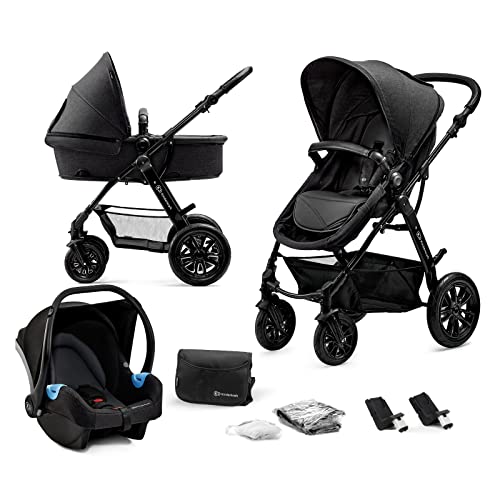The Prams Newborns Case Study You'll Never Forget
The Comprehensive Guide to Choosing the Right Pram for Newborns
The arrival of a newborn brings both tremendous delight and a range of choices that parents must navigate. Among the essential purchases is picking the best pram, which not just guarantees the baby's safety however also offers convenience for moms and dads. This guide intends to offer an extensive check out choosing the appropriate pram for newborns, going over different types, functions, security factors to consider, and maintenance tips.
Comprehending the Types of Prams
Prams vary widely in style and functionality, which can be overwhelming for brand-new parents. Here's a breakdown of the most typical types of prams readily available in the market:
Type of Pram
Description
Pros
Cons
Conventional Prams
Created for babies, these prams generally have a deep bassinet.
Comfortable for newborns, Safe for sleeping.
Large and heavy, Hard to steer in tight areas.
Travel Systems
A mix of a car seat and a stroller, allowing easy transition in between car and stroller.
Flexible and hassle-free, Cost-effective.
May be much heavier than standalone strollers, Not all parts are ideal for newborns.
Lightweight Strollers
Compact and simple to navigate, these are perfect for moms and dads on the go.
Portable and easy to use, Generally more affordable.
Less cushioning, May not recline completely for newborns.
Convertible Strollers
Strollers that can adjust from a carrycot for newborns to a young child stroller.
Multi-functional and lasting, Adjustable configurations.
Can be costly, May require more maintenance.
All-Terrain Strollers
Developed for rough surfaces, these strollers generally include bigger wheels.
Long lasting for outdoor use, Stable on numerous surface areas.
Much heavier and bulkier, Can be difficult to guide inside.
Key Features to Consider
When selecting a pram for newborns, a number of functions can considerably impact usability and safety. Here are vital functions to bear in mind:
- Safety Harnesses: Look for a pram that includes a five-point security harness to guarantee the baby remains secure while in transit.
- Reclining Seat: A completely reclining seat permits newborns to lie flat, which is essential for their spinal column and breathing health.
- Suspension System: An excellent suspension system supplies a smoother trip, vital for the fragile bodies of newborns.
- Brake System: Ensure the pram has a reliable brake system to avoid mishaps. Hand brakes or foot brakes can be reliable options.
- Storage Space: Consider a pram with ample storage area for diaper bags, shopping, or other basics.
- Weight and Foldability: Choosing a lightweight option that folds easily is important for convenience, particularly for public transport.
Safety Considerations
Focusing on safety is vital when it comes to prams for newborns. Here are crucial security suggestions to guarantee the well-being of your baby:
- Check for Stability: Make sure the pram remains steady when fixed. A large base can offer increased stability.
- Prevent Overloading: Only place products advised by the producer in the storage basket; excess weight can cause tipping.
- Regular Maintenance: Inspect the wheels, brakes, and harness systems consistently to guarantee they operate appropriately.
- Buckle Up: Always use the safety harness, even for fast journeys, to prevent the baby from slipping or falling out.
- Expect Age Recommendations: Follow the producer's standards concerning weight limitations and age recommendations for security.
Upkeep Tips
Taking care of a pram ensures its durability and safety for your newborn. Here are vital maintenance tips:
- Regular Cleaning: Wipe down the pram frame and wash fabrics according to maker directions to keep it sanitary.
- Examine the Wheels: Check wheels for damage and clean them regularly to prevent obstructed movement.
- Examine Folding Mechanism: Ensure the folding mechanism operates efficiently without sticking or jamming.
- Lubricate Moving Parts: Apply the proper lubricant to moving parts to guarantee quiet and smooth operation.
- Shop Properly: When not in usage, save the pram in a dry location to avoid rust and maintain material stability.
Regularly Asked Questions (FAQs)
1. The length of time can a baby remain in a pram?
For newborns, it is normally advised to limit uninterrupted time in a pram to about 1-2 hours to avoid issues with development and blood circulation.
2. Which pram is best for a newborn?
The best pram for a newborn is one that offers a fully flat recline, has a great safety belt, and satisfies existing security requirements. Many moms and dads prefer travel systems for their versatility.
3. Can I use a stroller without a safety seat for a newborn?
It's recommended to use a stroller with a flat or near-flat recline for newborns. Some strollers are only suitable from 6 months and up, so examine the maker's guidance.
4. When should I change from a pram to a stroller?
You can move from a pram to a stroller when your baby can stay up separately, usually around six months, however this can differ. It's always best to consult the private pram or stroller standards.
5. What is the very best way to clean my pram?
Always refer to the producer's directions, but typically, you can clean materials with moderate soap and water and clean down tough surface areas with disinfectant wipes.
Choosing the best pram for a newborn is a substantial decision that affects both the baby's convenience and the moms and dad's way of life. By understanding Pushchairs And Prams of prams readily available, key functions to consider, security strategies, and maintenance pointers, moms and dads can make educated decisions that improve their family's mobility and make sure the security of their kids. Investing time in research study now pays off in the long run for pleasurable getaways and treasured memories.
